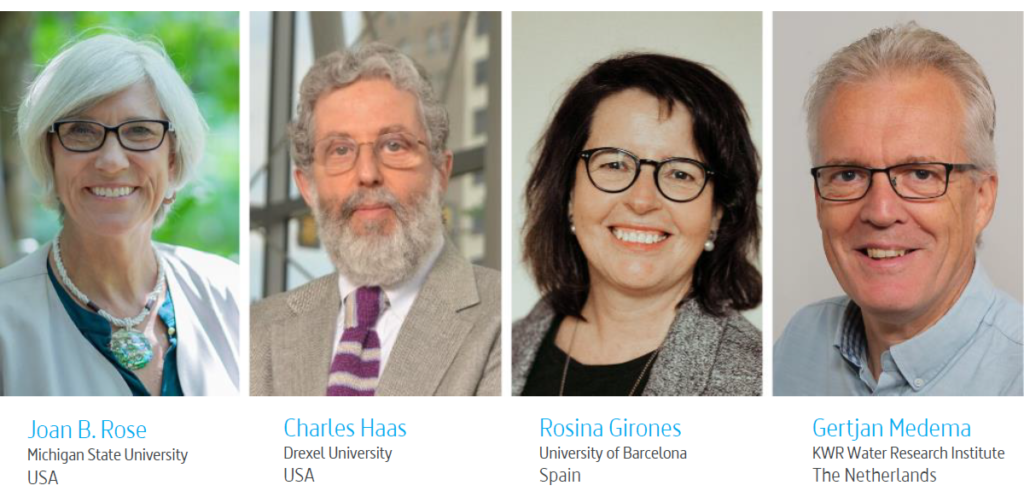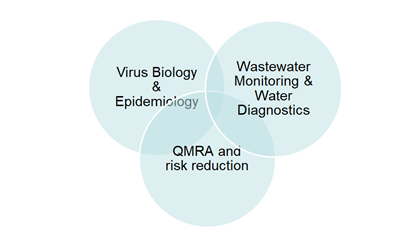A Technical Perspective On COVID-19
The Hague, 8 April 2020. The COVID-19 (SARS-CoV-2) pandemic is raising many questions for the water sector around the world. While operators provide their services within a national context, scientific and operational concerns and insights are relevant across borders.
The International Water Association (IWA) organised an online panel discussion focused on addressing the impacts of the virus for the water sector. The main conclusions are that the virus can be present in sewage but it is negative so far in treated effluents. No data exist for surface waters and groundwaters yet but the virus is much more fragile than other viruses and indicator viruses such as coliphage thus demonstrating much less potential for transport of live virus in environmental waters. Utility workers already taking sufficient measures to prevent contamination from other enteric viruses will be protected from COVID-19. Gloves and handwashing are imperative, face masks and protective eye wear are important in areas where aerosols could be generated.
The discussion highlighted that latest evidence combined with current understanding based on other viruses confirms confidence in existing drinking water treatment and in existing standard use of personal protection equipment by wastewater plant operators. Research opportunities include exploring further the potential for monitoring of sewage to reveal the rise of COVID-19 in urban populations. The discussion also drew attention to the importance of water, sanitation and hygiene in areas such as slums, given the important contribution of handwashing in helping reduce spread of the disease.
The panel was chaired by Professor Joan B. Rose, from Michigan State University, who highlighted the importance of water professionals from all over the globe as an industry an industry that is so critical to the well-being of societies, economies, and the environment and key for the current health crisis. “We should all thank our water professionals in our communities as part of the essential workforce during the COVID-19 pandemic, providing services we often take for granted,” said Professor Rose. “Focused on science and engineering, the water sector is doing its part to address COVID-19 pandemic and the ramifications of its spread.”
Professor Joan B. Rose led the discussion of noted specialists from around the world: Rosina Girones is Professor of Microbiology of the University of Barcelona and Dean of the Faculty of Biology in Spain. Charles (Chuck) Haas is Department Head, LD Betz Professor of Environmental Engineering, Civil, Architectural, and Environmental Engineering, Drexel University in Philadelphia. The panel also featured Gertjan Medema, Principal Biologist from KWR Water Research Institute in the Netherlands.
The expert panel tackled questions around three main areas, covering virus biology/epidemiology, monitoring, and quantitative microbial risk assessment (QMRA). The dialogue shaped the many concerns and questions related to this new virus and addressed the many common key questions that had come from the participants. These included the potential for waterborne disease transmission of the virus, given what we know about the biology and epidemiology of this type of virus. The risk for populations coming into contact with COVID-19 via sewage, water, biosolids, and aerosols in the urban water cycle. The approaches used by the industry to prevent occupational exposure. The ability to remove and inactivate the virus from sewerage, hospital wastewaters via secondary treatment and disinfection methods. Health implications due to lack of access to safe water or the risks associated with the presence of COVID-19 in developing regions of the world was touched upon.
The ability to monitor sewage and evaluate the concentrations of the virus in relationship to the disease in communities are possible. Ultimately the impact of this crisis on the water sector and water professionals as well as how this industry is protecting health will be addressed to acknowledge how the water sector is contributing to knowledge on the spread of this virus in our communities.
The panel was only able to answer a few set of questions in the one hour session, but the goal will be to produce an information sheet that can be shared in the future.
Rosina Girones said: “I think that excretion by a high proportion of children infected with SARS-CoV-2 in absence of clear symptoms, as it is suggested in some studies, could be an important source of virus in the sewage that would be good to quantify as soon as we have more quantitative data.” She added: “Sewage may be a potential source of contamination of SARS-CoV-2, especially at low temperatures. Until more data is available, it is expected that the new coronavirus would be less abundant as an infectious virus in sewage than known enteric viruses, and less stable in currently applied water treatments in wastewater or drinking water treatment plants.”
BIOLOGY AND TRANSMISSION
- Coronaviruses are a family of single-stranded enveloped RNA viruses. SARS-CoV-2 is 82% similar to SARS-CoV. It has round or elliptic and often pleomorphic form and a diameter of approximately 60-140 nm. The enveloped virus is considered to be less stable in the environment than most enteric viruses.
- Prolonged viral excretion may have important public health implications for the spread of the virus to other persons (bioaerosols) or to the environment fomite contamination. More knowledge of this is imperative.
- Transmission occurs via inhalation, fomite and hand contamination with exposure to the nasal and pharyngeal mucus membranes, but much less likely via direct ingestion.
Gertjan Medema stated “SARS-CoV-2 is detectable in sewage with RNA-based methods,” restating Charles Haas’s statement that it has not been found with culture methods and even from stools it is difficult to culture the virus. He continued: “We can find the virus in sewage even before cases are detected with health surveillance, so sewage surveillance can be an early warning tool and screening of absence in populations.” He concluded that “drinking water safety for viruses is long-established, and based on knowledge about removal of viruses (more robust than SARS-CoV-2) by water treatment processes.”
MONITORING AND SAFETY OF WATER
- SARS-CoV-2 is detectable in sewage with RNA-based methods. It has not been found with culture methods from sewage and even from stools it is difficult to culture the virus.
- We can find the virus in sewage even before cases are detected with health surveillance, so sewage surveillance can be an early warning tool and screening of absence in populations.
- Drinking water safety for viruses is long-established and based on knowledge about the removal of viruses (more robust than SARS-CoV-2) by water treatment processes.
Charles (Chuck) Haas highlighted the importance of the distinction between detection of RNA and of viable SARS-COV-2 virus. He said: “There are no reports of detection of viable virus at significant levels in excreta, however, RNA has been detected.” He noted that the persistence of SARS-COV-2 and amenability to chemical inactivation is similar to that of SARS, which in turn is more sensitive than other viruses encountered in the water sector. Concluding, he stated that “we have dose-response relationships of inhalation of SARS based on animal data; however there is yet no information on SARS-COV-2 dose-response.”
RISK & WASTEWATER TREATMENT ISSUES
- We have a number of dose-response relationships for inhalation of SARS based on animal data, and other respiratory pathogens. However, there is no information yet on SARS-COV-2 dose-response. So we have to use assumptions at this time.
- It is important to distinguish between the detection of RNA and detection of viable SARS-COV-2 virus. There are few reports of detection of viable virus at significant levels in excreta and none in sewage. However, the Virus RNA has been detected. This is important for Risk Assessment.
- The persistence of SARS-COV-2 and amenability to chemical inactivation is similar to that of SARS, which in turn is more sensitive than other viruses we encounter in the water sector.
About COVID-19
COVID-19 (SARS-CoV-2) is a respiratory virus with a long-term duration of excretion in stools.
Coronaviruses are a family of single-stranded enveloped RNA viruses. SARS-CoV-2 is 82% similar to SARS-CoV, It has round or elliptic and often pleomorphic form, and a diameter of approximately 60–140 nm. The enveloped virus is considered to be less stable in the environment than most enteric viruses.
Prolonged viral excretion may have important public health implications if responsible for spread of the virus to other persons or to the environment. Sars-CoV 2 seems to be very sensitive to temperature, resistant to pH, and sensitive to disinfectants.
More information



